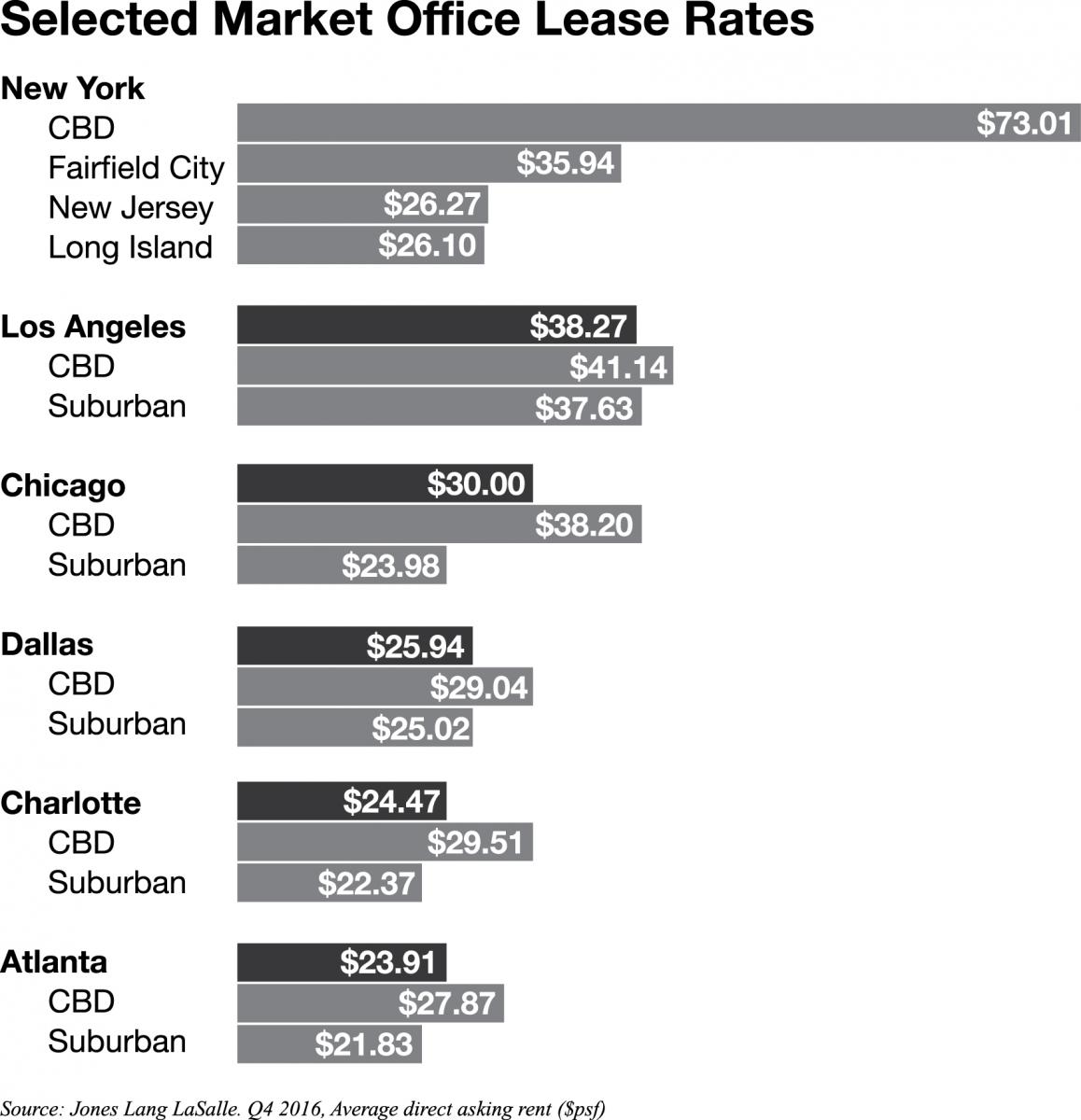
 Over the past few years, there have been some large headquarters relocation projects. While these projects do not happen regularly, they often are heavy publicized location decisions. For example, in just 2016, the following were some of the major headquarters relocation announcements:
Over the past few years, there have been some large headquarters relocation projects. While these projects do not happen regularly, they often are heavy publicized location decisions. For example, in just 2016, the following were some of the major headquarters relocation announcements:
• GE moving from Connecticut to the central business district (CBD) of Boston
• Sunoco to Dallas from Philadelphia
• Newell (formerly Newell Rubbermaid) to Hoboken, New Jersey, after merger
• Marriott to remain in Maryland but move to downtown Bethesda.
Headquarters projects are different from almost any other type of project. First, they are driven by at least one strategic issue, and oftentimes multiple strategic issues. These projects also vary in their scope by often beginning with a feasibility study and evaluating locations at different geographic scales. The criteria used for evaluating headquarters relocations are unique as well with an emphasis on the importance of the attraction and retention of top talent to the location decision.
Strategic Project Drivers
Traditional manufacturing and distribution projects are driven by the need for additional capacity, resulting in an objective site selection process and decision. Headquarters relocation projects often require that the site selection rulebook be thrown out. Driven by strategic issues unique to each company, and including the subjective voices of key stakeholders, each project is unique in its approach. There can be multiple strategic issues driving the project, often competing issues which further complicate the location decision. As varied as they may be, the strategic drivers of headquarters relocations can be grouped into two categories: cost and culture.
 When a headquarters operation in a large metro moves to a mid-market or a small market location, the strategic issue often involves cost. Public companies are driven by the need to increase profits, which can be accomplished two ways: increasing revenue and/or reducing operating costs. As costs continue to rise in major metro areas, many companies are faced with the decision to relocate to a lower-cost location. This may translate to a metro-to-metro move or a metro-to-suburb move. Mercedes moving from northern New Jersey to Sandy Springs (Atlanta) is a recent example of a company reducing costs with a headquarters move. Toyota also recently announced a move from Los Angeles to the Dallas suburb of Plano. In both of these examples, Mercedes and Toyota will be substantially reducing their operating costs as indicated in the chart showing the substantial variation in lease rates in select markets.
When a headquarters operation in a large metro moves to a mid-market or a small market location, the strategic issue often involves cost. Public companies are driven by the need to increase profits, which can be accomplished two ways: increasing revenue and/or reducing operating costs. As costs continue to rise in major metro areas, many companies are faced with the decision to relocate to a lower-cost location. This may translate to a metro-to-metro move or a metro-to-suburb move. Mercedes moving from northern New Jersey to Sandy Springs (Atlanta) is a recent example of a company reducing costs with a headquarters move. Toyota also recently announced a move from Los Angeles to the Dallas suburb of Plano. In both of these examples, Mercedes and Toyota will be substantially reducing their operating costs as indicated in the chart showing the substantial variation in lease rates in select markets.
While costs are frequently a driver, it is important to note that they are not the sole driver. It is important for a community looking to attract corporate headquarters to also have other advantages such as the ability to attract and retain top talent and/or above average access to air service.
Headquarters relocation decisions may be driven by an entirely different strategy: corporate culture. Projects driven by culture present themselves in a variety of ways. Often mergers and acquisitions prompt headquarters relocation because the company is trying to establish a new identity. For example, Hertz acquired Dollar Thrifty in 2012. Hertz was based in Park Ridge, New Jersey, and Dollar Thrifty was based in Tulsa, Oklahoma. In 2013, Hertz announced it was moving its headquarters to Estero, Florida, which is outside of Ft. Myers. In its press release, the company noted, “Hertz made the decision following its recent acquisition of the Dollar Thrifty Automotive Group.” Another example would be Newell announcing its move to Hoboken, New Jersey, in May 2016. Newell was formed from the merger of Newell Rubbermaid based in Atlanta, Georgia, and the Jarden Corporation based in Rye, New York.
Relocation decisions driven by culture may also be the result of a new CEO seeking differentiation from former leadership. A corporate decision to change the perception or image of a company may result in relocation. This would include a company needing to attract and retain top talent. GE’s move to Boston from Connecticut was driven by the interest to capture benefits of proximity to the innovative and talent-dense Boston metro. In these situations, a headquarters may relocate to a higher-cost location, but for these companies, the advantages of a higher-cost location negate the cost increase.
While it doesn’t fit cleanly into cost or culture categories, another reason for corporate headquarters relocation is proximity to key operations, especially manufacturing operations. In 2005, one of the strategic drivers for Nissan moving from Los Angeles to Nashville was to be closer to its manufacturing operations in the Southeast. In announcing its move to Atlanta in 2015, Mercedes cited the proximity of Atlanta to its Alabama manufacturing facility.

A company’s leaders know when the company needs additional manufacturing capacity or when it will need a new distribution center based on its projected store openings, but a company’s leaders don’t always know for sure that it will move its headquarters. The decision to relocate a corporate headquarters is not easy, or cheap. Relocations are emotional for all parties involved, especially employees and their families who are faced with the decision to uproot to a new area. As a consequence, headquarters relocation projects often begin with a comprehensive feasibility study to ensure that relocation is the right choice. Consultants are engaged to perform feasibility studies, often without even stepping foot in the candidate markets. In many cases, the project is over before it even began when corporate leadership decides the relocation is more costly or disruptive than was originally anticipated.
In some instances, a company’s management has already made the decision to move out of its current location because a circumstance such as needing more space or lease expiration arises. Since the company has already determined it will move, it may undergo a feasibility study to decide whether to relocate to a new space in the same market or relocate to an entirely different city.
Headquarters relocations differ from industrial projects even after the feasibility study. While the site selection process for an industrial project begins and ends at the county level, corporate headquarters rely on different units of analysis, beginning with metropolitan statistical areas (MSAs). MSAs are the collection of counties that make up a city’s regional economy and are the best available geographic unit to compare and contrast markets. Once a
project has narrowed down to a short list of MSAs, the analysis must continue to the submarket level, including both downtown and suburban areas. The area needs to be easy to access for employees and visitors as well as have access to a variety of amenities. Finally, the physical space needs to accommodate the design and culture of the headquarters. For many projects, it is not until the final metro area is determined that the company can narrow down to specific office buildings or properties under consideration.
Criteria for Headquarters Projects
The relative importance of location criteria used for headquarters projects varies substantially from other types of projects. As with almost any type of project, one of the key criteria is access to a quality workforce. While a manufacturing or distribution project relies largely on the existing labor pool, corporate headquarters projects depend upon the ability to attract and retain top talent. Headquarters projects likely involve a substantial relocation effort of key employees. The percentage of key employees who are asked to relocate and the percentage who accept the relocation can vary substantially between projects with the acceptance rate ranging from below 25 percent up to 75 percent. The more attractive the new location, the higher the relocation rate will be, but there are barriers that must be understood when considering a new location. According to Atlas Van Lines’ annual survey of corporate moves, 55 percent of employees who declined relocation did so because of a partner’s employment situation. Therefore, it’s important for a community to have a robust economy with a variety of employment opportunities available.
The cost of living in a new location is a similarly significant reason employees chose to not relocate. Cost of living impacts numerous aspects of a move, from relocating current employees to attracting new employees to setting wage scales for a new location. Current and future employees are also making sure the cost of living allows for a high quality of life. Employees are evaluating their personal tax situation including individual income taxes and sales taxes. Relocating to a state with no personal income tax from one that collects this tax is an instant pay raise for employees who move with the company, an enticement for many.
Other items evaluated as part of cost of living are housing costs, K-12 educational opportunities, cultural and recreational amenities, healthcare and commute times. For a headquarters that is currently located in a high-cost market like the New York City metro, a lower-cost location such as Charlotte, North Carolina, could offer existing and new employees a substantial savings on their cost of living while still offering a high quality of life.
In addition to existing employees, headquarters are constantly recruiting, so they must ensure they can find employees locally and attract key talent to the location. To determine the quality of talent in a market, a variety of comparable statistics are used, including population growth trends, employment in key occupations such as business and technical positions and proximity to colleges and universities. In 2016, McDonald’s announced a move from the Chicago suburb of Oak Brook to the West Town neighborhood of downtown. Marriott also announced a move of only five miles to a more urban location in downtown Bethesda, Maryland. In both cases, the companies noted that they were moving to be closer to the employees they were looking to recruit and retain.
As stated already, cost factors are important to corporate relocation, so it is no surprise that cost criteria are included in the site selection decision formula. Different from traditional industrial projects seeking to minimize labor and land costs, headquarters cost factors may include comparisons of office lease rates, parking and public transportation fees, relocation and benefits costs and air service.
Air service is a critical cost criteria for headquarters as they constantly have employees and clients coming and going. Not only is overall service evaluated, but specific routes are identified to key destinations, including other company locations. Having an airport hub, and specifically an international hub airport, is often a differentiating factor between locations for headquarters projects due to cost and time savings. For example, SunCoke Energy has operations around the world. When it moved to the Chicago suburbs from Knoxville, Tennessee, a key factor was the access to international air service so its worldwide locations could be reached.
Another criteria that impacts the bottom line is the legal and tax environment of a location. Income allocation for income tax considerations can make a big impact on the overall cost of operations for a company. Included in the tax environment is incentives. One of the biggest hurdles for a headquarters project is the large upfront employee relocation costs, but frequently this is not accounted for in the incentive legislation for most locations. Headquarters projects often occupy existing space, so while they may exceed the salary requirements for incentive programs, they may not meet the capital investment thresholds. Therefore, the communities that offer incentives that address the relocation costs may be a more appealing location for some large headquarters relocations.
While these are the most important factors and most frequent factors used to evaluate a headquarters location, it is important to note that each company and its reasons for relocation are different.
From the strategic drivers of the project to the criteria used for evaluation, a headquarters relocation project is unique and differs from more traditional manufacturing and distribution site selection projects. The strategic drivers are based around cost and culture, and the process frequently involves a feasibility study at the onset. Metro areas are used in the evaluation process versus county-level data used for other types of projects. The criteria used emphasizes making sure the location selected for a new headquarters operation will be a strategic move that makes a difference in company operations. TID

